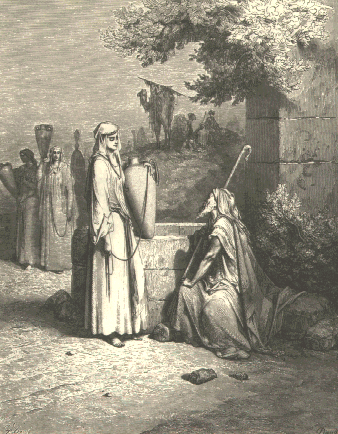
Parashat Chaye-Sarah
“…and he took Rebecca as his wife. Isaac loved her, and thus found comfort after his mother’s death. And Abraham added and he took another wife, whose name was Keturah, etc., but to Abraham’s sons by concubines Abraham gave gifts.” (Genesis 25:1-6)
“And he took a wife.” Rabbi Yehuda says this is Hagar. So why is it written “And Abraham added”? This means continuous action, etc. And why is it written “whose name was Keturah”? He said, her fulfillment of commandments and good deeds was pleasant as incense (ketoret). Then, why is it written “and to Abraham’s sons by the pilagshim“? He said, “It is written pilagsham.” (Bereshit Rabbah parsha 61, brought in the Rashi.)
We brought this medrash to show how the Sages interpret the Torah as though it were their own and make the Torah as clay in the hands of the sculptor and as an axe in the hands of the woodcutter. In the verse it is written that Abraham took another wife and the verse even specifies her name, Keturah. Even so the Sages, for reasons unclear, perhaps they feared the plain meaning (Abraham married again because he was envious of Isaac marrying Rebecca), went and distorted the text and claimed that Keturah was Hagar, but her fulfillment of “commandments and good deeds was pleasant as incense. (ketoret)”
And Ibn Ezra, with no fear, wrote simply and clearly, “Keturah is not Hagar, as it is written ‘and the sons of the concubines’.”
This is another thing which is important and note-worthy—the way the medrash says the text is to be written. In the medrash it says pilagsham, but in the Torahs scrolls we possess it is spelled plene, pilagshim! Therefore we see that the Torah scrolls of the authors of the medrash were different from the ones we possess. Do not think that a problem with deficient and plene spelling in the Torah is only a matter for medrashim; see Tractate Sanhedrin 4b, “letotefet, letotefet [deficient] and letotafot [plene], so you have here four.” That is, there are four chambers in the head phylactery.
According to the Baraita there is a vav between the pay and the taf, and therefore it is the plural, totafot — two. But when there is no vav between thepay and the taf then totefet is singular, and the Tosfot asked, “and it is worth wondering, for there is no vav between the pay and the taf everywhere.” That is, according to our tradition totefet is always written without a vav between thepay and the taf, and therefore there should be three chambers in tefillin and not four.
But do not be overly concerned about the errors of defective and plene spelling, for they are so numerous that Meiri on Tractate Kiddushin 30a explained that one should not invalidate a Torah scroll based on defective and plene spelling errors, as we are not expert in them (and in the ninth pamphlet we will clarify this issue at length). This matter of errors in the transmitting of “defective and plene” traditions from generation to generation is only natural, because people make mistakes and add or lose letters in what is written; everyone who deals with manuscripts will testify to that. G-d took pity on his nation Israel and gave wisdom to the Gentiles — they invented the computer, which can scan the number of letters and their place; many books were found to be error-laden.
But what should concern you and make you question is the excuse of the above Tosfot: “some explain that as it is written u’letotefet and they take thevav from the beginning of the word and add it to the end of the word and then interpret as though it were written so.” This is what we’ve said again and again: our sages make themselves as though they were consulting with G-d in secret, taking away letters from the Torah when they wished and adding letters when they so desired, and then interpreting. It is not enough that the sages of the Gemara moved verses written in the Torah, as brought in Tractate Baba Kama 107a, “R’ Chayim Bar Yosef said there is a mixture of sections in what is written here,” and Rashi explains that “a verse from a different section was mixed into one from a different place.” But even the Rishonim, long after the Talmud was sealed, came and took away and added and moved letters to their hearts’ content.
And you, the honest student, wise of heart, pay heed to these words. Understand that anyone who comments on the letters in the Torah and faithfully believes that the text, which we hold, is exactly that which came down from Sinai, is mistaken. The letters and words and verses were moved, changed and switched, added to and taken away from over the course of centuries and millennia by the writers and copyists and sages and exegetes. There are not only 70 facets to the Torah; there are also hundreds of different formulations.
Words of true knowledge
